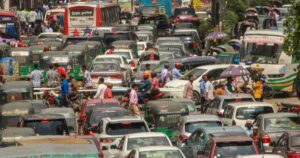by Mohit M. Rao
• A study shows that air pollution causes behavioural, physiological and genetic changes in wild bees.
• Pollutant impact on bees is observed even in areas well-within the current national standards for Particulate Matter pollution.
• Pollution impacts survival rates among bees exposed to air pollution and could harm pollination services in forest or agrarian ecosystems near urban areas.The blanket of pollutants that seems to have found permanence in the air of India’s cities is not just taking its toll on human health. Pollutants are causing behavioural changes, irregular heartbeats, immunological and genetic changes in the giant Asian honeybee, which leads to lower survival rates, shows a study by researchers from the National Centre for Biological Sciences (NCBS).
The study suggests that urban air pollution may adversely affect other critical pollinators and could have worrisome implications, not only on urban forest landscapes but also on agriculture in peri-urban and rural areas.
The paper, published recently in the Proceedings of the National Academy of Sciences, USA, observed physiological, morphological and expressions of genetic characteristics of 1,820 wild bees (Apis dorsata) in Bengaluru over the past four years.
The giant Asian honeybee is a common resident of urban Indian cities and is also an important pollinator in India’s agrarian and forest ecosystem. Bengaluru’s urban expansion, like other Indian cities, has had an alarming impact on its air. Particulate Matter 10 (PM10) – a term encapsulating suspended pollutants lesser than 10 microns in diameter – exceeded national standards in six out of seven sites in the city between January and March 2020. Meanwhile, the city population has tripled since 2000, and the area under vegetation has shrunk by 88 percent in four decades.
“During some local observations in our home city (Bengaluru), we noticed fewer pollinators in urban centres of the city. Was it pesticide use that caused this? Lack of water or shade?” said Shannon Olsson, Principal Investigator at the Nature-Inspired Chemical Ecology group at NCBS and one of the authors of the study.
This eventually led to Geetha Thimmegowda, lead author of the study, travelling to different locations around Bengaluru to observe and collect the giant Asian honeybee.
The NCBS team picked four sites – rural, less-polluted areas, moderately polluted and heavily polluted areas – for observation and collection of bees between January 2017 to April 2019. While rural areas had an average PM10 concentration of 28.32 microgrammes per cubic meter, the highest polluted site exceeded 100 μg/m3.
Pollutants coat the bees
Researchers observed lower flower visitation rates – that is, the number of bees per inflorescence (clusters of flowers) – in highly polluted sites compared to sites with low pollution levels.
Pollution also seemed to have a direct correlation with the survival rates of bees. Bees collected from moderate and highly polluted areas died within a day of collection: 80 percent of bees from these areas died within 24 hours, and all of them died within 1.5 days in the laboratory. In comparison, 50 percent of bees from rural and lesser polluted sites died on the first day, while many lived for up to four days.
The hindlegs, antennae and wings of bees collected from polluted areas were covered in particulate matter. The pollutant coating contained heavy metals such as arsenic, lead and tungsten, which are toxic to insects.
Unlike humans, where asthma and respiratory problems are the most common pollution-related ailments, there seems to be no difference in the respiration of bees from rural areas and highly polluted areas. However, pollution was found to impact the heart, causing irregular heartbeats. Pollutants also reduced the total hemocyte count, affecting immunity levels in the bees and expression of genes that regulate stress, immunity and metabolism. The effect of air pollution on bees was observed to be similar to the adverse reactions to pesticides.
“As we know, air pollution has been linked to higher rates of respiratory diseases, cancer, heart disease, stroke, asthma in humans. So, all the results (in bees) were more shocking and depressing than surprising,” said Thimmegowda.
However, she added that it was “surprising” to notice the significant differences in bees from polluted and highly-polluted areas, considering that Bengaluru’s average pollution levels are significantly lower than air quality recorded in places such as Delhi, Kanpur, Lucknow.
The laboratory is continuing experiments to determine which component within the cocktail of chemicals that form air pollution cause the specific effects seen in this study.
It isn’t just the city’s urban gardens and forests that may be impacted. Giant Asian honeybees are capable of long-distance migration of 100-200 km, and any potential effects of pollution in cities may carry over to areas around the city.
N. Nagaraja, an apiculture expert from Bengaluru University who has been studying bee migrations within Bengaluru, said Apis dorsata populations tend to migrate out of the city during summers and rainy seasons.
“They head for the hills or in the agricultural plains where floral resources will be available compared to cities. This migration is important for flowering plants because unlike other bee pollinators, A. dorsata will visit even flowers with low sugar concentrations in the nectar. It plays the critical role of pollination,” he said.
“Better air quality standards”
The paper also suggests that these results may not be limited only to the giant Asian honeybee. To rule out other environmental aspects accounting for these results, researchers repeated the experiment on laboratory-reared common fruit fly (Drosophila melanogaster) exposed to similar levels of pollution. The experiments confirmed the results obtained in field studies. It also raised the possibility of pollution having detrimental effects on other insect species in urban areas.
“We cannot say if the results would be the same for all of the wide variety of insects (flies, moths, butterflies, beetles, ants, etc.) that serve as pollinators, but our study does show that our results are not taxon-specific since both bees and flies were affected in a similar manner,” said Olsson.
Currently, the national permissible limit for PM10 is 60 μg/m3, which is exceeded in most cities. However, even this level had an impact on the bees, reducing its survival rates and affecting the number of flowers visited.
“Physiological and molecular information like we gathered is essential to understand what specific impacts air pollution has on wild systems and what air quality standards would be needed to ensure their wellbeing,” said Olsson.
Arunabha Ghosh, CEO of the Council on Energy, Environment and Water, who was not part of the study, said that the findings underscore the need to raise India’s ambient air quality standards. “From a policy perspective, we need more dense air quality monitoring networks in agricultural areas and more impact studies so that we have a better sense of how air quality is likely to impact pollinators and plants in various regions,” he said.
Source: Mongabay India




